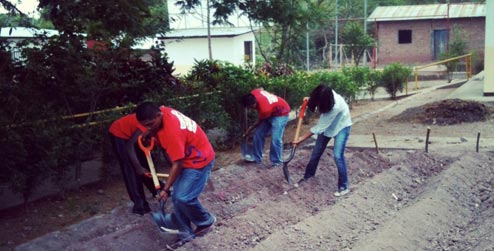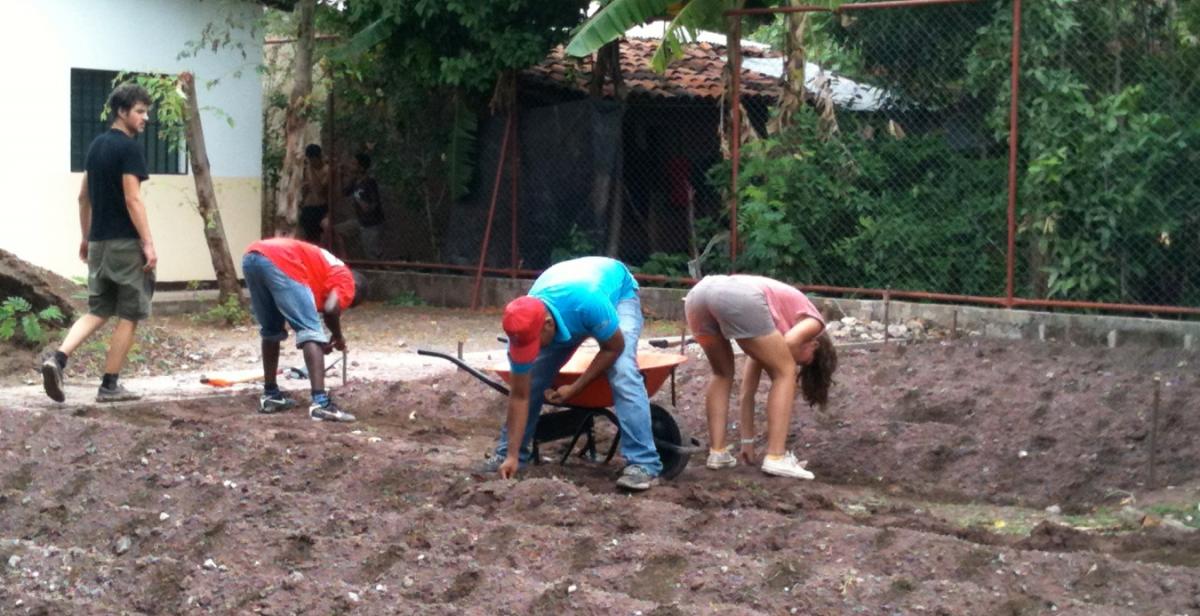It’s a Tuesday, and once again we are trundling along an undulating road towards Palacaguina through the mountainous terrain of northern Nicaragua. We are on the way to a centre that is split in to two sections: half is a pre-escolar (pre-school) and the other is Asilo de Ancianos, a care home for the elderly. To hear of such necessities in Nicaragua is a rarity, but a much-appreciated service for those that get to obtain the education or receive the tender loving care in some of the most vulnerable years of their lives.
Fortunately for Palacaguina, a Spanish cooperative funded the construction of the modern centre, which provides care to 8 permanent residents and 25 non-permanent locals (health checkups, birthday celebrations, regular meals, therapy sessions etc.) and provides pre-school to a host of toddlers. The pre-school children are also selected as being the most vulnerable in the area.
‘The children that come here have dads that stay at home [due to a lack of work], and who live on 50 dollars a month, for 5 to 6 children’, explained Maira, the centre’s coordinator.
However, due to underfunding, the 25 non-permanent attendees in Asilo de Ancianos only receive 2 meals a week: ‘the elderly should be able to come for food everyday’, said Maira, resolutely.
In total, it costs the centre 10,000 cordobas to provide care and meals for the elderly and the children, roughly 400 dollars. A very small amount compared to UK costs, but a large sum of money in Nicaraguan terms.
Cue the Progressio ICS volunteers! The group began digging two vegetable patches for the centre; one for the pre-school and one for Asilo de Ancianos. It’s been a laborious process thus far: pickaxes have been wielded, heavy metal bars have been thrust in to the hard terrain, and sweat has poured in litres, not millilitres. After three sessions, the patches are ready for an application of organic fertilizer and pesticides, and subsequently, the soothing part - the planting.

With Nestor, FENCOOP’s facilitator, we have calculated some extraordinary yields from the patches:
• In half of plot 2 (plot one has not been prepared as of yet), the centre will have 50 chiltoma plants (miniature peppers), producing roughly 1000 chiltomas
• In the larger half of plot 2, 160 tomato plants will be planted, producing approximately 3500 tomatoes
• In plot 3, 11 ayote plants (from the squash family) will be planted, producing 110 ayotes; 10 pipian plants, producing 250 pipians; 8 pepino plants (cucumbers), producing 200 cucumbers; and 6 watermelon plants, producing 60 watermelons.
It is clear that not all the produce will survive the wrath of pests and disease, so some deductions will surely be necessary, but with such large quantities, the vegetables that make it to harvest will help with the centre’s finances – less on the weekly grocery shop! - and provide sustenance to more of the local children and elderly; the intended purpose of the patches in the first instance.
On a deeper level, it helps to establish ‘food security’. According to the World Health Organisation (WHO) ‘food security’ is built on three pillars. Food availability: having ‘sufficient quantities of food available’. Food access: having a diverse range of nutritious food available on a consistent basis. And, food use:’ appropriate use [of food] based on knowledge of basic nutrition and care’. A vegetable garden contributes to meeting all three of the above ideals.
Local growing also increases a community’s ‘resilience’. According to the Transition movement, who have been successfully promoting local growing throughout 100s of communities in the UK, ‘’resilience is the ability of a community to withstand shocks from the outside”. A non-resilient country or community would be one which is vulnerable to the unavailability of critical food supplies due to various risk factors including droughts, shipping disruptions, fuel shortages, and economic instability.
For example, the UK is vulnerable because of dependence on imports and the complex supply chains which have to be undertaken just to get food to the supermarkets: think of the oil-based pesticides, the natural gas-based fertilisers, the lorries, the ships, the planes, the packaging and the refrigeration needed before a majority of food reaches the shelves. All of this relies on fossil fuels. If oil prices were to increase then food prices would increase and if any of these supply chains were to cease, the UK would be left at risk, because we simply do not have the knowledge of growing, the domestic infrastructure, or the community relations to be able to feed ourselves in a more self-sufficient way. This makes the UK non resilient.
Nicaragua is more resilient in some senses, but less in others. It grows most of its staple foods domestically on its fertile land, and only really relies on imports for non-food items. The problem for Nicaragua is its focus on a few food commodities. This makes it non-resilient because if these foods decline in productivity due to global warming, or suffer loses due disease and pests, the people will be at further risk of already omnipresent malnutrition. By encouraging local growing – something that is relatively common in Nicaragua already – through the vegetable patches, the group is encouraging diverse food sources embedded within communities, empowering future generations (particularly the pre-school) by giving them a space to learn about how to recycle seeds and grow plants, considerably reducing ‘food miles’ because the centre can get a large source of their nutrition right in their own back yard, and it helps strengthen the communities social glue – not that Nicaragua needs a lot more of this! And for all of the volunteers, particularly the internationals, many of us will of learnt how to prepare a vegetable patch and plant; education all round then.
By Andrew Tappin




Comments
Andrew some very valid points
Andrew some very valid points on food security. Well done in imparting your knowledge and your team's valuable work in Nicaragua!